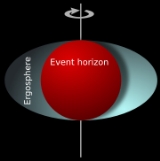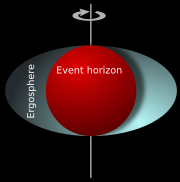
Ergosphere
Encyclopedia

Rotating black hole
A rotating black hole is a black hole that possesses spin angular momentum.-Types of black holes:There are four known, exact, black hole solutions to Einstein's equations, which describe gravity in General Relativity. Two of these rotate...
. Its name is derived from the Greek word ergon, which means “work”. It received this name because it is theoretically possible to extract energy and mass from the black hole in this region. The radius of ergosphere at equator corresponds to Schwarzschild radius
Schwarzschild radius
The Schwarzschild radius is the distance from the center of an object such that, if all the mass of the object were compressed within that sphere, the escape speed from the surface would equal the speed of light...
of non-rotating black hole and with minimum radius at poles (down to a half of Schwarzschild radius for maximally rotating black hole).
The ergosphere is ellipsoidal in shape and is situated so that at the poles of a rotating black hole it touches the event horizon
Event horizon
In general relativity, an event horizon is a boundary in spacetime beyond which events cannot affect an outside observer. In layman's terms it is defined as "the point of no return" i.e. the point at which the gravitational pull becomes so great as to make escape impossible. The most common case...
and stretches out to a distance that is equal to the radius of the event horizon. Within the ergosphere, spacetime is dragged along in the direction of the rotation of the black hole at a speed greater than the local speed of light in relation to the rest of the universe. This process is known as the Lense-Thiring effect or frame-dragging
Frame-dragging
Einstein's general theory of relativity predicts that non-static, stationary mass-energy distributions affect spacetime in a peculiar way giving rise to a phenomenon usually known as frame-dragging...
. Because of this dragging effect, objects within the ergosphere are not stationary with respect to the rest of the universe unless they travel faster than the speed of light, which is impossible based on the laws of physics. But in truth, particles are not moving with that speed, it is the spacetime of the ergosphere that moves with a speed higher than the speed of light. A suspended plumb, held stationary outside the ergosphere, will experience infinite/diverging radial pull as it approaches the static limit. At some point it will start to fall, resulting in gravitomagnetically induced spinward motion. Another result of this dragging of space is the existence of negative energies
Negative energy
Negative energy is a concept used in energy , energy , and speculative fiction for a contrast with regular or positive energy.Negative energy may be used in:- Physics :* Particle physics** Exotic matter** Antiparticle...
within the ergosphere.
The outer limit of the ergosphere is called the stationary limit or static limit. At the stationary limit, objects moving counter spinward at the speed of light are stationary with respect to the rest of the universe. This is because the space here is being dragged at exactly the speed of light relative to the rest of space. Outside this limit space is still dragged, but at a rate less than the speed of light.
Since the ergosphere is outside the event horizon, it is still possible for objects to escape from the gravitational pull of the black hole. An object can gain energy by entering the black hole’s rotation and then escaping from it, thus taking some of the black hole's energy with it. This process of removing energy from a rotating black hole was proposed by the mathematician Roger Penrose
Roger Penrose
Sir Roger Penrose OM FRS is an English mathematical physicist and Emeritus Rouse Ball Professor of Mathematics at the Mathematical Institute, University of Oxford and Emeritus Fellow of Wadham College...
in 1969, and is called the Penrose process
Penrose process
The Penrose process is a process theorised by Roger Penrose wherein energy can be extracted from a rotating black hole...
. The theoretical maximum of possible energy extraction is 29% of the total energy of a rotating black hole. When this energy is removed, the black hole loses its spin and the ergosphere no longer exists. This process is considered a possible explanation for a source of energy of such energetic phenomena as gamma ray burst
Gamma ray burst
Gamma-ray bursts are flashes of gamma rays associated with extremely energetic explosions that have been observed in distant galaxies. They are the most luminous electromagnetic events known to occur in the universe. Bursts can last from ten milliseconds to several minutes, although a typical...
s. Results from computer models show that the Penrose process is capable of producing the high energy particles that are observed being emitted from quasar
Quasar
A quasi-stellar radio source is a very energetic and distant active galactic nucleus. Quasars are extremely luminous and were first identified as being high redshift sources of electromagnetic energy, including radio waves and visible light, that were point-like, similar to stars, rather than...
s and other active galactic nuclei.
The size of the ergosphere, the distance between the ergosurface and the event horizon, is not necessarily proportional to the radius of the event horizon, but rather to the black hole's gravity and angular momentum. A point at the poles does not move, and hence has no angular momentum, while at the equator the distance covered by a point in the black hole within a given time is greater than any other point at the black hole, which gives it the greatest angular momentum. This difference of angular momentum that extends from the poles to the equator and is reflected over the equator is what gives the ergosphere its oblated shape. If the gravity or the rotation speed increases, the size of the ergosphere increases as well. Conversely, if they decrease the size of the ergosphere decreases too.

